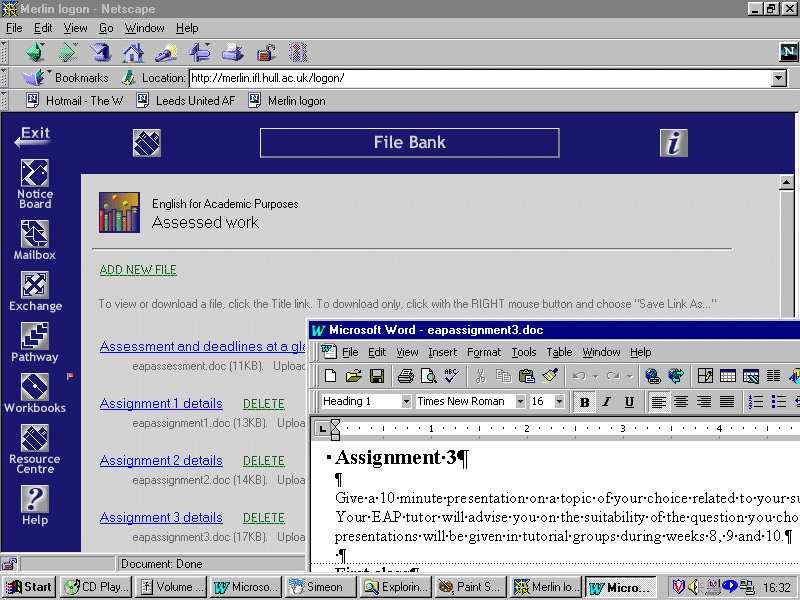| ITMELT '99 Conference |
|
On this site: Conference 1999 Home Page, Accepted Abstracts; Call for Papers; Hotel Accommodation, Conference Schedule.
An English for Academic Purposes module via the Merlin Internet learning environment
David Oakey
Language Institute
University of Hull
England
Introduction
This paper describes a component of an English for Academic Purposes (EAP) module which is delivered via Merlin (Multimedia Educational Research into Learning via an Information Network), a web-based learning environment developed at the University of Hull. The paper first outlines the rationale for using an online component of this module and then gives an overview of the component's principal features. The final section of the paper briefly describes the issues of student training and tutor remuneration, which have some bearing on web-based course design and provision.
Rationale for using an online component
Provision of EAP for in-sessional students at the University of Hull takes the form of a ten-credit module offered twice in each academic year. The module lasts for 11 weeks with two hours a week face-to-face class time, and follows a task-based, integrated textual skills syllabus. It aims to enable students to approach, use and produce text types within constraints pertaining to genres in their area of study. The early stages introduce students to skills required for approaching written texts, such as prediction and skim reading, before moving on to skills required in using written and spoken texts, such as note-taking and summary writing. As the module progresses, students move on to practising the skills required for producing spoken and written texts.
The need for an online EAP module component became apparent during the first semester of the 1998-1999 academic year, when the limitations of the traditional mode of delivery were revealed. Registered on the module were close to 150 students from a wide range of departments, all with differing levels of English proficiency, with strengths and weaknesses in different skill areas, and with differing expectations of what the module could offer them and what they could learn from it. Students’ other course commitments made it difficult for tutors to stream tutorial groups according to level and subject discipline. In addition to this, limited resources meant that face to face contact time on the module had to be divided into one hour given in plenary and one hour taught in tutorial groups. Timetabling constraints from students’ home departments meant that some students were unable to come to the plenary hour, while others were unable attend their tutorial group hours with any regularity.
Under the credit system at Hull, a 10-credit module represents 100 hours of study, so that, in addition to the 22 hours tuition received face to face, evidence of another six hours a week of independent study is required of students. In this module, independent study was intended to be the time in which students related the general EAP content of the plenary and tutorials (EGAP) to the more specific requirements in their own disciplines i.e. ESAP (Blue 1988: 96). It was difficult for the results of any independent study to be monitored, guided or evaluated when tutors and students only met face to face in tutorial groups for one hour a week. There seemed also to be a tendency for students not to do any independent study if they expected to receive little individualized feedback on it.
Prior to adopting the EAP Merlin component, an attempt was made to structure independent study for students by email. Weekly emailshots went out containing the overhead transparencies from the plenaries and tutorials, plus lecture and tutorial notes, in order to ensure that all students received the course materials electronically. Each tutorial class ended with an ESAP independent study task (such as examples of how writers in a particular subject discipline express uncertainty) which students were encouraged to email back to their tutor. However, the interaction between tutor and students this way was haphazard and time-consuming. The mailshots went from one point (tutor) to many (students), while replies came in from various points and got mixed up with the tutor’s other email messages. The tutor had to reply individually to these messages, creating records of student replies and tutor comments manually in order to build a "thread" of interaction. This left little time to help those students who were not familiar with email, or check up on those who were not doing the required independent study. In addition attendance at plenaries and tutorials fell off when students realized the emailshot content was identical to that delivered electronically.
Creating a module component in the Merlin environment was far more than putting lecture and tutorial notes on the web. It allowed the dropping, on-line at least, of the plenary/tutorial distinction, one that did not have any pedagogical justification. It made electronic interaction easier by replacing the weekly emailshot with a fixed central pathway. It allowed students to access course content materials outside scheduled plenary/tutorial times, thus bypassing the timetabling constraints. It also released tutorial group time for work on presentation skills. It was also intended to increase interaction between students in groups and on the whole module. The final consequence of the Merlin component was that it simplified administration by tying course registration to Merlin registration.
EAP Merlin component design
Merlin is a web-based learning environment first developed by the University of Hull and British Telecom to support distance teaching and learning (Marsh et al., 1997; Arnold et al., 1997). It is a password-protected environment to which students do not gain access until they have received their passwords at module registration.
The standard screen, which the student sees on accessing Merlin, can be seen in Appendix 1. The dark blue banner around the edge of the screen is a permanent feature, and clicking on the icons on the banner takes the student to different areas of the environment. This entry page contains the Notice Board, which holds messages from the EAP tutor and the Merlin system administrator. The tutor uses the Notice Board for administrative messages giving details of room changes, elections of student representatives, reminders of approaching assignment deadlines and so forth. The Notice Board connects to the Who’s Who area, which contains students’ and tutors’ homepages. Each homepage contains a photograph and resumé of the personal and academic interests of the group member. These are intended to help students to identify other students on the EAP module who are studying the same discipline, but who could not be put in the same tutorial group because of timetable restraints. Students can also see who else is online at the same time as themselves.
The central feature of the environment is the Pathway (Appendix 2). The Pathway is divided into eleven stages to match the eleven weeks of the module, and the tutor is able to control student access to each stage. For example, the screen in Appendix 2 was created in the sixth week of the module, and it can be seen that Stage 7 was not then available to students. This access control facility was useful since it was not possible to create the entire module content in the Merlin environment before the module started. Each stage on the Pathway contains tasks that supplement the content of face-to-face classes for that week. The student is intended to follow the tasks in sequence, although there is no way for the tutor to ensure that this happens. Each task states its title and learning aim and gives some input. This is followed by a Point to ponder, which highlights a feature of the input on which the student is intended to reflect. This reflection either feeds into the input of the next task, or generates a piece of written work, known in the Merlin nomenclature as a workpiece. It can be seen that the task in Appendix 3 requires the student to send a workpiece to the Group Workbook. This can be read and commented on by all students in the group. Input from some tasks is by way of links to other websites, or links to other resources within the environment. Developing the component, although time-consuming, was not particularly complicated since creating stages and tasks in Merlin does not require any specialist knowledge of programming languages. Appendix 4 shows how the tutor prepares a task by adding title, aim and task text to a ready-made template.
Each student has two workbooks. The Group Workbook is common to all students, while the Personal Workbook is their own private space to which they submit work required in stage tasks. Most stages require students to submit two workpieces. The tutor also receives all workpieces in his or her own workbook, and can search for workpieces by a particular student, as illustrated in Appendix 5. This is the part of the environment through which much of the tutor feedback is given. Appendix 6 shows a workpiece by Alfredo (not his real name) which he submitted to his Personal Workbook as part of a task in Stage 2. The tutor attaches comments and suggests changes to the student’s workpiece. The student can in turn respond to this feedback, and the process continues until some negotiated final position on the workpiece is reached. Appendix 7 shows the exchanges between Alfredo and the tutor for this particular workpiece. This record of interaction remains in the student’s Personal Workbook, and is thus a more permanent reminder than feedback given orally. The Group Workbook is for students to discuss issues raised by particular tasks. There are discipline-specific exchanges to which students studying related subjects can share information about the English related to their discipline. At of the time of writing, these collaborative features of the Merlin environment had not been used much by students, and are not discussed here.
As mentioned above, the input for some tasks needs to be accessed by links to other parts of the EAP Merlin environment or the World Wide Web. The tutor organizes these links in the Resource Centre (Appendix 8). This area contains links to Internet resources such as online dictionaries and other EAP websites, and also links to source material for producing texts. The later stages of this module take a product-based approach to the teaching of writing, and tasks in these stages require students to practise writing texts with particular functions. In Stage 8, for example, students are required to produce a short text classifying a subject or group of objects. The task asks them to choose a link from the "Text functions: Classification" category to a site containing information which the students then use in producing their text.
The Resource Centre also contains links to other areas within the Merlin environment, which are used as task input. There are a number of lectures that are stored in RealPlayer audio format. These are overviews of a variety of subject specialisms aimed at a non-specialist audience which are given by newly arrived professors at the University of Hull. These lectures are used since they are relatively easy to record and, with the permission of the lecturer, do not present any copyright difficulties. As required by a task, students listen to the section of the lecture that accompanies the lecturer’s Powerpoint slides. Other tasks direct the student to listen to the entire lecture without breaks. The other function of the Resource Centre is administrative. Information which might not otherwise reach all the student body at the same time is kept in the File Bank, which is shown in Appendix 9. Files stored here contain assignment details, marking criteria, and answers to "discrete item" tasks.
Monitoring of student access to the Merlin component of this module is through the Log-on Reports feature of the environment. This function allows the tutor to see how often a student has accessed the module, although the report does not give any more specific details like the duration of access, the tasks read, or the resources used. Since the component is not part of the accredited EAP module specifications, the number of occasions a student accesses EAP Merlin cannot affect his or her final mark. The reports are nevertheless useful in charting the frequency of access once the module is evaluated at the end of the semester.
Development Issues
The Merlin environment and Pathway template were provided by the Merlin Development Unit (MDU) in the Institute for Learning at the University of Hull. This last section looks at two issues related to the EAP module component which arose during discussions with the MDU. The first of these concerned the amount and type of student training prior to and during the module. It was decided that students would be given a one hour introduction to the environment and two hours hands-on training in groups with the tutor in computer rooms. A series of ten general Merlin introductory tasks were adapted by the tutor for use by the EAP students. In completing these tasks, such as sending a message to their tutor, opening a file in the File Bank, or following a link in the Resource centre, students used every part of the environment. It remains to be seen how well these tasks helped students conceptualize the shape of the environment. Merlin has relatively few layers, but, since many links to different parts of the environment open in new browser windows, the unwary student can sometimes get lost in a multitude of windows within the same environment.
It may be that this disorientation arises from the fact that the Internet has no standard metaphor. Technological innovations are often described metaphorically so that the people expected to use them can understand them, e.g. Microsoft's Windows operating system uses buttons, icons, and tools; text can be cut and pasted and stored on a clipboard. The Internet is an extremely complicated phenomenon made simpler through metaphors such as web or net. The problem for students new to the web is that web-related conceptual metaphors are only partially applied linguistically. Students have a fair idea of what is meant by a net or a web, but when a web has pages, sites and links instead of strands, strings or nodes, the reasons for the terms are divorced from the original simplifying metaphor. In such cases another simplifying conceptual metaphor takes over, that of a home site, or base or headquarters. The notion of depth is similarly difficult for newcomers to grasp. When a link is clicked it is not always obvious to the user if he or she is going forward on the same level, or down to a more specific layer.
The other issue which has certainly caused much debate during development of the EAP Merlin component is that of staffing costs. While the Personal Workbook section of the Merlin environment simplifies the tutor’s access to students’ work, it also creates an avalanche of workpieces. Students have until three weeks after the opening of the stage to submit workpieces for that stage, so tutors need to provide feedback at varying times. The relationship between a traditional paid hour in the classroom and an hour tutoring on Merlin is unclear, since using an hour as a unit of cost in an asynchronous learning environment is problematic. The traditional payment structure for face to face teaching is that of 3:1: for each hour taught in class, it is assumed the teacher spends an hour preparing and another hour marking, making three hours in total. But what is the ratio when the tutor is only tutoring on Merlin? The tasks are structured so as to enable the student to learn, and the tutor’s role is primarily to give feedback on student progress through the tasks. If the tutor has had no part in preparing the material which students are working on independently, and is not teaching face to face hours in the classroom, it may be that they are only paid for the time they spend giving online feedback. The situation is further complicated when the tutor is teaching both face to face and on Merlin. It has yet to be resolved whether Merlin tutoring time for these tutors is part of the 3:1 face to face time, or should be remunerated separately.
Conclusion
In conclusion, the EAP Merlin component is still at a developmental stage. It has brought tangible benefits by simplifying the time-consuming administrative aspects of an EAP module with a large and diverse student body, in a UK university context where student numbers are increasing and classroom contact hours are limited. It has allowed students access to the module independently and enabled tutors to give feedback on students' individual performance without taking up class time. The principal issues which remain to be resolved are the difficulty in building online collaboration between students for ESAP tasks, the danger of insufficiently preparing students for online environment navigation, and remuneration for the increased tutor workload.
References
Arnold, I., Ellis, N., Halliwell, J. & Marsh, D. (1997). Merlin - EFL on the Internet. In P. Grundy (Ed.) IATEFL 1997 Brighton Conference Selections. Whitstable: IATEFL
Blue, G.M. (1988). Individualising academic writing tuition. In P.C. Robinson (Ed.) Academic Writing: Process and Product. ELT Documents 129. London: Modern English Publications.
Marsh, D., Arnold, I., Ellis, N., Halliwell, J., Hodgins, C. & Malcom, S. (1997). Project MERLIN: A learning environment of the future. ReCall 9(1), 52-54.
Appendix 1

Appendix 2
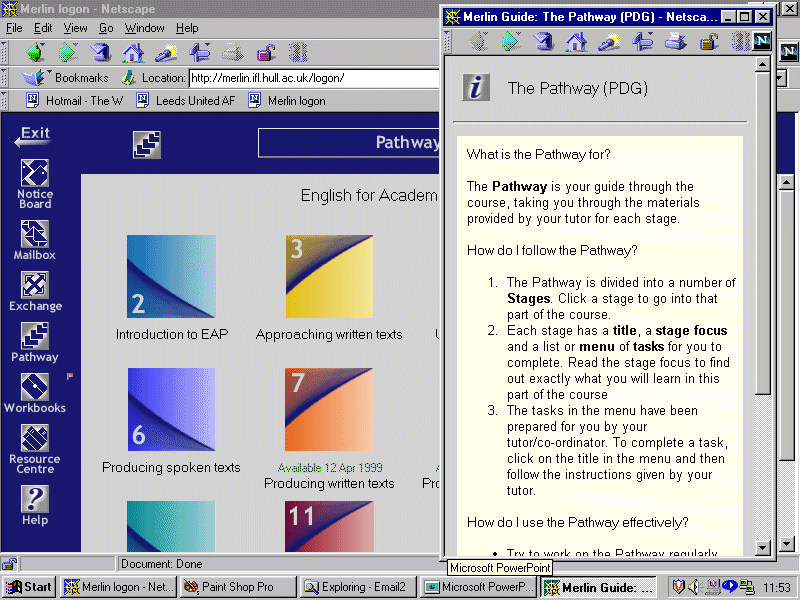
Appendix 3

Appendix 4

Appendix 5
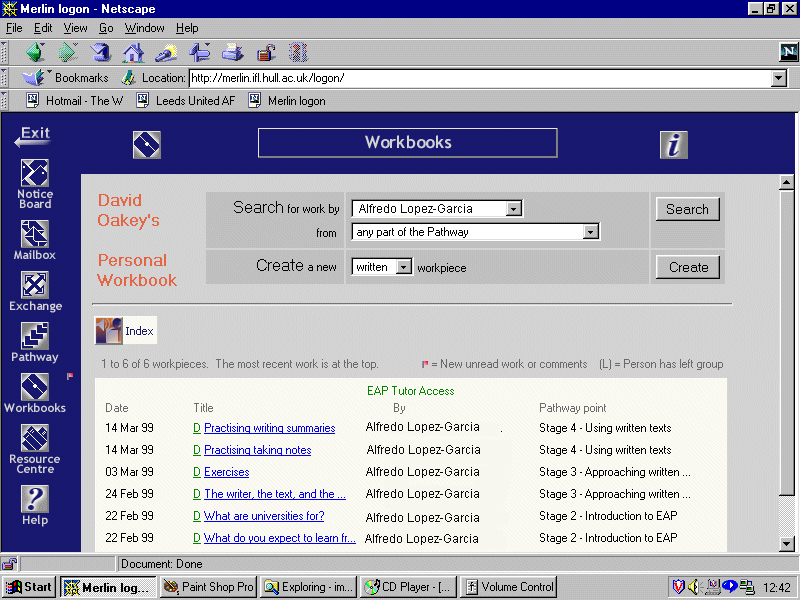
Appendix 6

Appendix 7
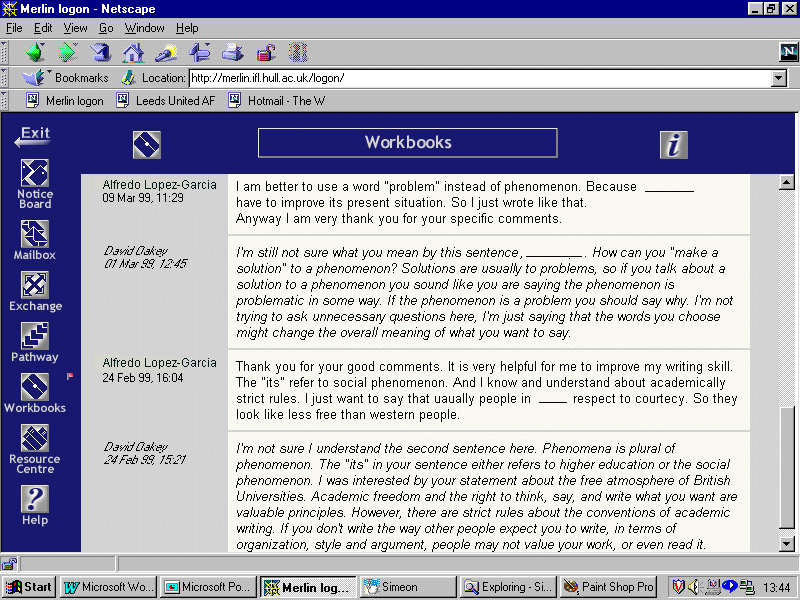
Appendix 8
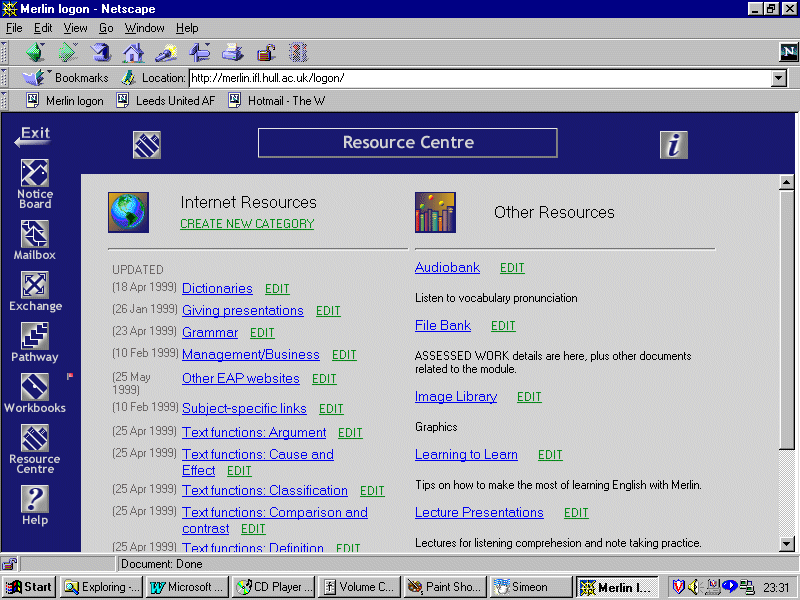
Appendix 9
